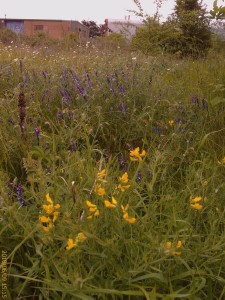The onslaught against the most valuable wildlife sites in Bexley is set to continue this week as the planning committee meets on 14th April to consider an application to redevelop the old Electrobase industrial site between Hall Place and Crayford town centre. This would be acceptable in principle were it not for the fact that the proposal includes destroying a prime part of the adjacent Crayford Rough Metropolitan Site of Importance for Nature Conservation. Bexley Council’s case officer has recommended that the whole plan – which would see more than twice as many flats built as agreed in the Council’s own Crayford town strategy – be approved. As usual absolutely no data or peer-reviewed evidence is presented to support the implicit pretence that this will not have a deleterious effect on the range or populations of the species of particular conservation concern that are present, or the Borough’s biodiversity as a whole or that the so-called ‘mitigation’ proposed will adequately ‘offset’ those impacts.
In our opinion the officer’s report, which is one of 145 documents about this planning application, the one most likely to be read by councillors, and the one that will shape their reading of any of the others, is insufficiently explicit about the loss of MSINC land. It leads with ‘the proposal will reuse a former brownfield site in a relatively sustainable location on the edge of the Crayford District centre.’ and goes on to say ‘The western area of the site abuts Crayford Rough a designated SINC which is largely grassland and woodland.’ A casual or hurried reading could well leave the impression that the Rough itself will not be directly affected. Whilst a part of the National Planning Policy Framework is quoted, it is not the part about biodiversity considerations.
Bexley Natural Environment Forum will be objecting and has requested a speaker slot at the meeting. Bexley Civic Society has also objected on both environment grounds and the size and density of the proposed ‘development’.
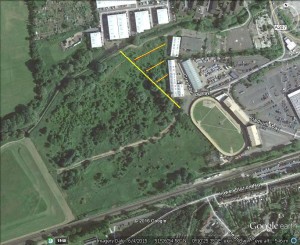
Crayford Rough. Google Earth image showing the area proposed to be built on (yellow hatch), which is 10% of the whole MSINC, is very important for wildlife and is outside of the old industrial estate fenceline.
BEXLEY’S ‘GROWTH STRATEGY’: CRAM THEM IN AND LOSE MORE VALUED OPEN SPACE
The applicant proposes building 359 residential apartments in 5 and 6 storey blocks. This should be compared with the ‘up to 150’ agreed as acceptable for this site in the Council’s ‘Crayford Strategy and Action Plan’ (2005), which went through another of its famous public consultation exercises. We note that the officer explicitly links this more than doubling in numbers, and the loss of a significant part of the Rough, to the Council’s ‘growth strategy’. The ‘strategy’ has yet to be agreed, and there is no electoral mandate for its core policy of increasing the borough’s population by one fifth, as previously revealed on this website. There is also a passing reference to what is in reality Boris Johnson’s ‘densification’ plan, which sees Bexley as a prime building site to help serve his ambition of a 3 million increase in the population of London as a whole.
CRAYFORD ROUGH – A TOP LONDON WILDLIFE SITE
There are few Sites of Special Scientific Interest in London designated for their wildlife value, and none in Bexley. The Rough is one of only five Metropolitan SINCs in the Borough, the next highest ranking after SSSIs, as is the River Cray, also impacted by this proposed ‘development’. That means that after an objective assessment by experts, it has been identified as one of the best wildlife sites in the whole of London. The grossly delayed 2013 SINC review has confirmed this status. The SINC citation says that the site ‘has developed a variety of habitats supporting an exceptionally diverse flora and fauna.‘ There is no real recognition of this in the officer’s report, or understanding of the variation in habitat across the Rough, such that the ten percent that would be built on is a large part of the most valuable area of the Rough for protected reptiles and for the flora in question.
CART BEFORE HORSE WILL FAIL TO PROTECT FLORA
By their own admission, the people who did the ecological assessment for the ‘developer’ only surveyed the site on ONE DAY. Rightly recognising the serious limitations of this they said:
7.16 It is recommended that a detailed botanical survey is undertaken between mid-May and the end of June to inform suitable mitigation and enhancement strategies.
but then spoilt it by saying this:
7.17 The protection and enhancement of the site for flora could be secured through a planning condition. Suggested wording:
‘Recommendations regarding flora should be adhered to, as outlined within Section 7 of the Lloyd Bore Ltd, Ecological appraisal (3162_RP_001 Ecological appraisal. Lloyd Bore Ltd. 2014). In
addition, details of the ecological mitigation strategy should be submitted and agreed to in writing before vegetation clearance, ground works or other preparatory works are commenced.’
Even the woeful National Planning Policy Framework says that planning permission should be refused if the damage is too great and cannot be mitigated. There has been no such thorough survey, so how can the Council determine whether this test can be met or not before voting on this application, which is surely part of its legal duty to consider biodiversity properly into account in all its decision-making? The answer is it can’t, so is this complacency, ignorance, ineptitude or sheer arrogance? Its recent antics point to the latter.
The survey such as it was identified a list of pretty common species, but not all of the rare species in the SINC citation. Whilst the nationally scarce Yellow Vetchling, and Pyramidal Orchid were noted, the obvious importance of this open part of the Rough for them and other key species, as opposed to the more scrubby and coarser grassed remainder, was not made clear.
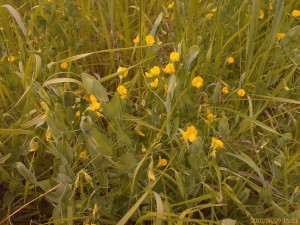
Yellow Vetchling (Lathyrus aphaca) is nationally scarce. Apart from a small population at Erith Marshes, it is confined to this open part of Crayford Rough, where the biggest population is found, with far lesser amounts at Braeburn Park and by a ditch the other side of the A2. (Photo: Chris Rose)
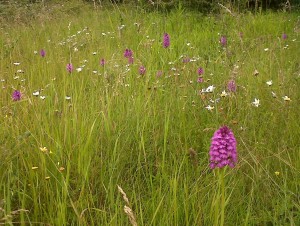
Crayford Rough is perhaps the only remaining site for Pyramidal Orchid in Bexley (there may be some at Braeburn), and the only place in the Borough where the uplifting sight of any numbers of any Orchid can be seen. It is found in, and requires the sunny open areas of which a large part would be destroyed by this ‘development’. (Photo: Chris Rose)
VANISHING BEE ORCHIDS
The previous SINC citation stated that there was a very large population of Bee Orchid (Ophrys apifera). The words ‘very large’ have been removed from the 2013 version. BNEF’s own wildlife recording operations had found just a few flowering plants left, all in the area proposed to be built on. This information was furnished to Bexley Council’s Biodiversity Officer, the Nature Conservation Officer and the Environment Agency back in 2014, but is not mentioned in the planning documents.
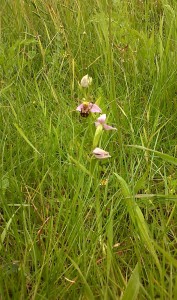
A Bee Orchid flowering at Crayford Rough in July 2012. Only a few plants were found, all in the area proposed for destruction. (Photo: Chris Rose)
There are only around half a dozen sites in Bexley with any Orchids at all, and the Rough is the only one with an impressive show. All the others have just one, or very few, plants.
BEXLEY COUNCIL’S WAR ON REPTILES CONTINUES
In 2014 Jason Steel, an experienced reptile surveyor with Kent Reptile and Amphibian Group, reported that he had seen about 50 Common Lizards on the now threatened part of the Rough, which was the largest number he’d ever seen, even though he had done a fair amount of reptile field work. Only this week he has confirmed the high importance of this part of the site for this species, and for Slow Worms.
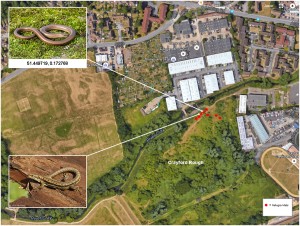
Jason Steel, a surveyor for Kent Reptile and Amphibian Group, confirmed the importance for reptiles of this threatened section of the Rough on April 5th 2016. Not only might this be lost, but the rest would then be overshadowed by a 6 storey block of flats.
All UK reptile species are Biodiversity Action Plan priorities, meaning the objective is to increase the number of populations and size of populations. In the past seven years Bexley Council’s response to that has been to approve building on three reptile sites, including Erith Quarry, where it seems to have agreed before any population estimate was available, that the ‘developer’ would be allowed to leave only 3.25ha of suitable habitat. The population density turned out to be such that twice that was actually required, but the blithely Council approved the plan anyway. It also oversaw a translocation, contrary to national guidelines, from another site, in which Common Lizards were moved to an unsuitable area of habitat which its own plans said was ‘insufficiently mature’ for them. Limited monitoring says very few have subsequently been found there.
In the case of Crayford Rough we are being told that the reptiles will be turfed out of the 10% onto the rest of the site, and that with a few log piles and a bit of rotational mowing Bob’s yer uncle. As with the destruction the other sites mentioned, no attempt has been made to determine the population of the affected site/area, or the population in the ‘receptor site/area before the planning decision is made, and there is no evidence presented by the Council’s Biodiversity Officer – or anyone else – to support the implicit contention that there will be no negative effect on the overall population after this happens. Nor is the Council proposing that there be any proper monitoring of numbers after the event. Nor, as usual, is there any attempt whatsoever to put this in the context of the overall conservation and survival prospects for these species in the Borough as a whole, which is thoroughly irresponsible.
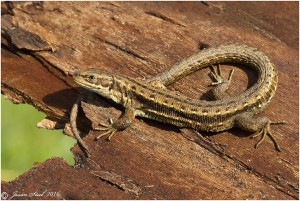
Common Lizard at Crayford Rough, April 2016. They may have been common once, but they are now in decline, a situation reinforced by a series of recent Bexley planning decisions. The Council has not thought it relevant get data on or to consider the number and sizes of populations in the Borough before voting to cover yet more of their homes in concrete. (Photo: Jason Steel)
All habitat at the Rough is not equal for reptiles, with much of the rest of it being too scrubby or having too coarse a grass sward. And since the Council voted to trash the fantastic Erith Quarry scrub habitat, no, we don’t want big swathes of the scrub here cut down ……. With a 6 storey block planned to abut what will be left of this currently highly reptile-friendly part of the site, there should also be an assessment of the ecological effect of the shading that it will have on this area. But there isn’t.
ROBBING PETER TO PAY PAUL
The one bright spot in all this is that ‘the applicant has now agreed in principle to them gifting the area of the Rough to Council with a commuted sum in the order of £204,000 for maintenance and enhancement of walkways in the Rough area along the river and across the Rough. This is similar to the transfer of the Rough that was historically in the ownership of J Sainsbury when they expanded their existing store into the former Homebase building a few years ago and will allow the Council to manage the overall area for the benefit of all existing and future residents of Crayford and the surrounding area. This will be in addition to the habitat enhancement works that will be undertaken by the applicant on the Crayford Rough prior to the handover of the Crayford Rough to the Council. This provision will be covered in the S106 legal agreement.’
But BNEF is getting fed up of hearing that the only way to look after area X of high wildlife value in the Borough is to flog off and/or allow development of high wildlife value area Y. Several important sites in Bexley are managed by volunteers, and will it cost £200K to look after some paths in what should be kept an informal area anyway?
We think this is a trade-off too far. The logic is that one day Bexley will want to concrete the penultimate green square metre of the Borough to ‘protect’ the final one. It can’t dispute this because it does not recognise or define any point at which it considers there will ever be enough ‘development’.
POLICY TESTS
BNEF also believes that the proposal to destroy 10% of the Rough fails the following policy tests and/or that no or inadequate evidence is presented to prove that it doesn’t:
Then National Planning Policy Framework 1.14 states that ‘When determining planning applications, local planning authorities should aim to conserve and enhance biodiversity by applying the following principles:
- if significant harm resulting from a development cannot be avoided (through locating on an alternative site with less harmful impacts), adequately mitigated, or, as a last resort, compensated for, then planning permission should be refused;
The London Plan (2011, 2015), Policy 7.19 Biodiversity and Access to nature, says:
C: Development proposals should:
b prioritise assisting in achieving targets in biodiversity action plans (BAPs) set out in Table 7.3 and/or improve access to nature in areas deficient in accessible wildlife sites
c ….. be resisted where they have significant adverse impact on ….. the population or conservation status of a protected species, or a priority species or habitat identified in a UK, London or appropriate regional BAP or borough BAP.
E: When considering proposals that would affect directly, indirectly or cumulatively a site of recognised nature conservation interest, the following hierarchy will apply:
1 avoid adverse impact to the biodiversity interest
2 minimize impact and seek mitigation
Bexley Core Strategy policy CS18. Bexley Council’s policy is to protect and enhance biodiversity in the Borough. We take this to mean NET enhancement. Core Strategy policy CS18 c commits Bexley Council to ‘resisting development that will have a significant impact on the population or conservation status of protected species and priority species as identified in the UK, London and Bexley Biodiversity Action Plans;’
The Council’s ‘Crayford Strategy and Action Plan’ (2005) which set an upper limit of 150 flats for the site.
It also said that there should be ‘No residential development on the Rough within or at the expense of the character of the Green Belt.’
The Council is playing games around ‘within … the Green Belt’ as a mapping anomaly means that the part of the SINC affected is inexplicably outside of the Green belt boundary, but since a whopping 6 storey block of flats would then be put up against the Green belt boundary, we suggest that this is at the expense of the character of the Green Belt.’ in this particular location.
APOLOGIES FOR THE ‘LATE NOTICE’ …..
BNEF has fallen down on this one, and only spotted a couple of days ago that it was going to planning committee this week. We had, however, put it in writing to the Council in May 2015 that we could support the development on the industrial site per se, but not on any part of the open Rough, and that we would also support a higher than usual density to achieve that outcome. Now it would appear that we have got the worst of both worlds. We had also written four times to the Council’s Biodiversity Officer, who sits in the planning department, asking for an update in response to our input, but can find no reply to the first three e-mails. A reply was eventually forthcoming last week, when the Nature Conservation Officer gave no hint that a decision was imminent. Given that we spent a long time in what we thought was constructive engagement on biodiversity matters, including this particular issue, we would have appreciated a ‘heads up’, We are also seeking an answer from the Council as to how it is that BNEF is a formal consultee over Crayford Marshes, but has not been treated as one on the Crayford Rough or the Borax Fields planning applications, which may have given us earlier warning.
Chris Rose. Vice-chair, BNEF.

